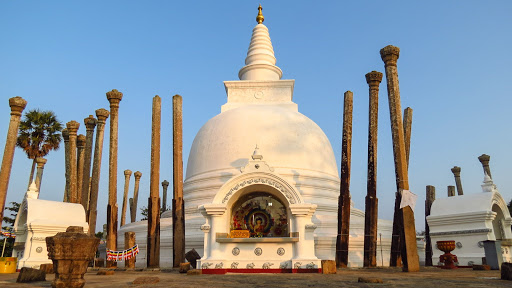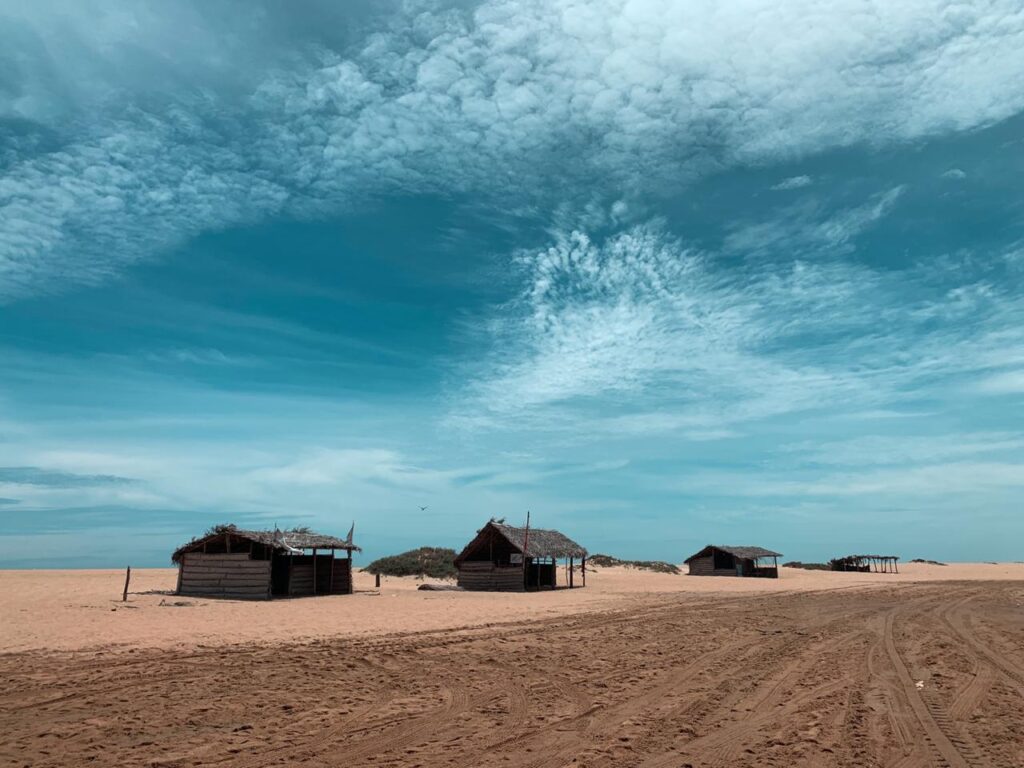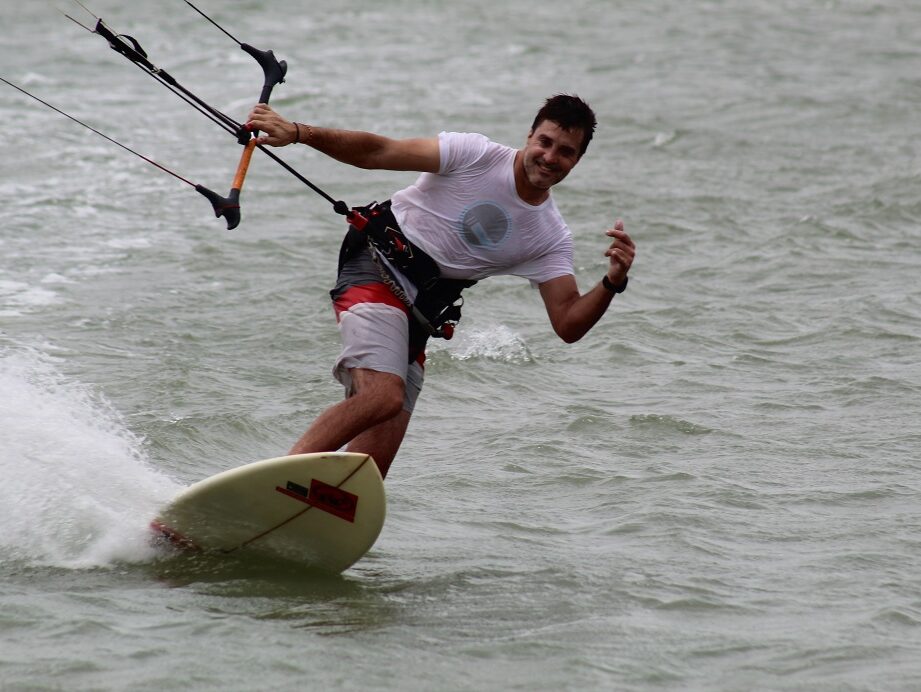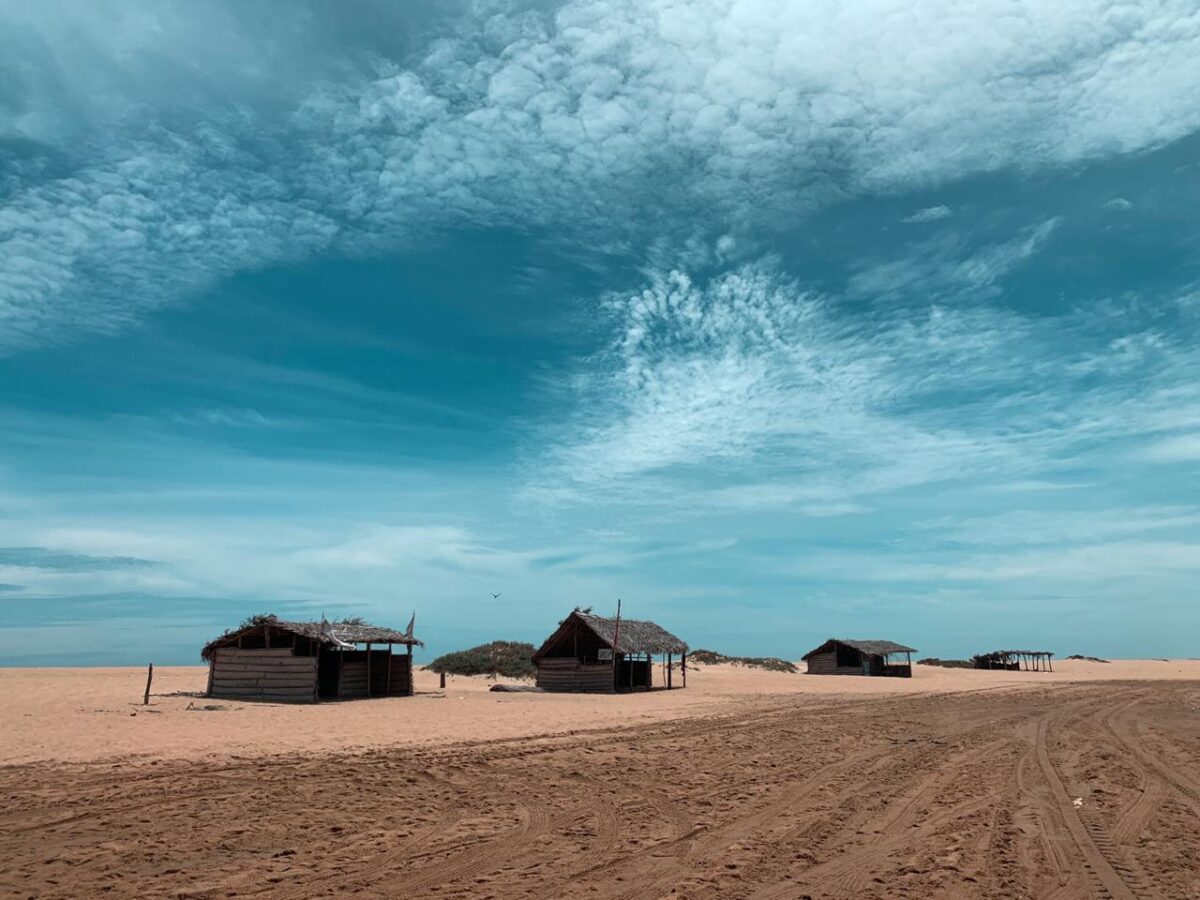- Primary kitesurfing seasons: From May to October (18-25 knots) and From December to March (14-20 knots)
- Best kitesurfing destination in Sri Lanka: Kalpitiya and islands around
- Kite sizes you will need: summer season (9-10 m) and winter season (12-14 m9
- Spot conditions: Flatwater/beginner level
Until very recently only adventurers and explorers dared to venture onto this great island, which was hardly developed for tourism at the time. But the exposed location in the Indian Ocean and the constant ventilation of the changing monsoon winds have triggered a veritable kite boom in recent years.
Until 1972, the small island state southwest of India was still known under the name Ceylon. At that time, Ceylon was able to make a name for itself primarily through its excellent tea-growing regions. However, as so often in colonial history, this did not lead to wealth for the island. Since independence from the British Empire in 1948, the newly founded democracy has now tried to regain its strength – and to politically unite the multi-ethnic and multi-religious population as much as possible. Buddhists, Hindus, Christians and Muslims live together here. In recent years, the media have repeatedly reported isolated unrest, particularly from the Tamils, Sri Lanka’s largest minority. But the civil war was officially declared over in 2009, and so the country has apparently come to rest – and at the same time has become attractive for tourists, not least for tourists hungry for wind.
Spoiled by the monsoons
Due to its location in the warm Indian Ocean, Sri Lanka is reliably ventilated all year round by the two prevailing monsoon winds. In summer it blows more strongly from the south-west, in winter the opposite blow from the north-east. Surfers, kiters and windsurfers make pilgrimages to the island all year round to enjoy the fantastic conditions on the water and to catch some of the magic of Sri Lanka.
In the small fishing village of Kalpitiya, 165 km north of Colombo, a considerable kite scene has developed over the past few years. Just six years ago you saw the first locals on the lagoon doing their tricks on the shallow water. Since then, the region has turned into a real water sports Mecca. Warm temperatures all year round, first-class spots and the good wind statistics attracted my girlfriend and me like small children to a decorated Christmas tree. Surfing in the south and kiting in the north: sounds like a perfect destination for water sports enthusiasts.
Impressive landscapes and cultural diversity
But not only the water and wind conditions make this island an exciting holiday destination. Breathtaking landscapes, the multi-layered cultural influences and, last but not least, the sometimes wild animals that can only be admired in zoos in this country are worth the trip alone. We were also able to experience the local population as friendly, very helpful and courteous – a welcoming culture from which some countries could learn a decent slice. In addition to kiting time, you should definitely plan a few additional days of travel to explore the country. It is worth it!
Kitesurfing seasons in Sri Lanka
From May to the end of September you can expect south-westerly winds of 18-30 knots every day in the Kalpitiya lagoon, which can sometimes be a bit gusty. In winter, the lagoon blows in exactly the opposite direction from the northwest, so that there is no turbulence from the land and the wind is more constant but somewhat weaker. In January and February, you can expect moderate winds up to the 20-knot mark. Dolphin and whale watching are also popular around this time in the Kalpitiya region. With an average of 32 ° C air and 27 ° C water temperature, the wetsuit can safely stay at home.
From December to February the wind blows mostly at a moderate 15-20 knots from the northeast, perfect for kiters of all skill levels. Nevertheless, in winter you should also have the big kites in your luggage for days with less wind. In the summer months from May to September, the motto is: “bring your smallest kites”, as the wind blows mercilessly almost every day from morning to evening at 20 knots from the south-west. March, April, October and November are the months with the weakest wind and can also be quite rainy. Summertime attracts most water sports enthusiasts, so you should put up with not being the only one on the water. With year-round outside temperatures around 30 degrees and water temperatures around 28 degrees, you can leave your wetsuit at home in the closet. However, you should definitely not do without lycra or shirt as sun protection and sun blocker, as the sun burns intensely from the sky.
Learn more about kite sesons in Sri Lanka

Kitesurfing spots:
Kalpitiya lagoon
The Kalpitya Lagoon is the most perceived and well-known lagoon in the region. There are several kite stations and resorts in the immediate vicinity. As a rule, recording and preservation take place on the narrow tongue of land between the lagoon and more. The resorts have tossed their way back and forth between the palm trees and the personal bank, the kiter between bed and board. With the shallow water area that is quickly continuous and shallow, it can get full here from noon onwards, but there is still alternative space available. In the windier summer months, the wind blows diagonally onshore on the lakeside and brings with it a small, choppy wave. No matter if you are a beginner, a climber or a professional – Kalpitiya works for everyone. Between the sessions, you can relax wonderfully in the shade in the small bungalows and earn a cool income or go back to the resort for an extensive lunch break. The only downer: At the beginning of the summer season, the wind can be a bit gusty. It is reliably calm but should stabilize over the course of the summer months.
Kandakuliya lagoon
In Kandakuliya you can find the little brother of the Kalpitiya Lagoon. It was due to different rights only 2.5 years ago. The north-east wind blows perfectly onshore in the winter months, so that behind the sandbanks, mirror-like water, financial freestylers and speed freaks find the right north playground. Beware of your own fishermen. They have the lagoon to belong to the mouth of the open sea with their small boats. But the fishermen are very friendly to kiters and even cheer us on for the second trick. Since Sri Lanka, unfortunately, has a problem with washed-up garbage, the banks in the north of the island are usually not entirely free of waste. Thin neoprene shoes are our advice.

Dream Spot
The Dream Spot really deserves its name. It can be reached by a 20-minute boat tour, which usually starts from Kalpitiya. Once there, there is a sandbar that separates the sea from the lagoon. On the lakeside, you will find small waves, and on the lagoon side flat water, fans will get their money’s worth. To organize such a trip, it is best to ask at your accommodation or inquire directly with the kite schools. The costs are around 25 to 50 euros, depending on additional services such as food and drinks.
Magic Spot / Vella Island
The Dream Spot is only surpassed by the Magic Spot, also known as Vela Island. You can also take a boat to reach an offshore island in one to one and a half hours north. From there, the group – accompanied by the boat – goes by downwinder to the actual attraction of the day trip: the crescent-shaped headland of Vela Island. Here the wind is blowing offshore and ironing the water as smooth as a fluffy carpet. Also, the wind comes undisturbed over the open sea, is therefore much more constant and usually a little stronger than on the lagoons around Kalpitiya. No wonder that you often come across freestyle professionals here who use this unique spot for training.
Ippantivu island
Also called Mini Vella, this spot brings all together; that is good wind and butter flat water. Halfway from Vella, it is the ideal getaway from Kalpitiya. A downwind trip from Dream spot it is also recommended
Down here you will find other interesting kite spots in Sri Lanka worthy to visit:
- The Donkey Point
- Puttalam lake
- Mannar – Adam´s Bridge
- Arugam Bay
- Ahamgama Beach
Learn more about Sri Lanka kite spots
Learn kitesurfing in Sri Lanka. What are the primary certified IKO schools in Sri Lanka?
Do you want to learn kitesurfing in Sri Lanka in a picturesque setting? Then the beginner courses are just right for you. The on-site trainers usually speak English with the absolute basics. You learn the theory, right of way and basic techniques. If you can steer the kite, get on the board and do the first few meters on the water. Soon you can really kitesurf and are probably already planning your next kitesurfing holiday in your head. With the right course, anyone can actually learn to kite. In Sri Lanka also in the unique environment.
Certified IKO centres:
- Margarita kite school (main IKO centre in Sri Lanka)
- Valampuri resort
Primary kitesurfing camps in Sri Lanka (all of them right at the kite spot)
- Kitelantis
- Margarita kite camp
- Sunwind beach Kalpitiya
- De Silva wind restort
Tips &advices
Arrival: The flight connections to Colombo are very good from many European airports and the travel time is quite bearable for kiters. If you can catch a fast connection, you can be in Colombo in thirteen hours. If you take kite luggage with you, you should definitely check with the airlines beforehand, as complications can arise at the airports. Or you can book through one of the relevant tour operators and save yourself the stress. It’s just 160 kilometres from Colombo to Kalpitiya. You can travel quickly and comfortably by shuttle for around 70 to 80 euros, which is organized by the kite resorts. Bargain hunters and adventurers can also get to Kalpitiya publicly by bus and train. This is much cheaper, but it also takes a good six hours. The local taxi drivers usually only offer overpriced trips to Kalpitya. An entry visa is required for Sri Lanka. You can buy it at the airport for $ 40 or online in advance at www.eta.gov.lk for $ 35.
Accommodation: Since word of the good water sports conditions around Kalpitiya has spread, the resorts are springing up like mushrooms. After a short research, you will find numerous offers in all price categories. Most resorts have their own restaurants and offer good local cuisine with freshly caught fish.

